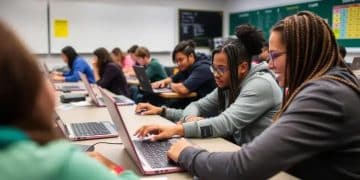School curriculum reform to include financial literacy

School curriculum reform to include financial literacy is essential for equipping students with the skills to manage money effectively, make informed decisions, and prepare for a financially responsible future.
School curriculum reform to include financial literacy is becoming increasingly important as students face complex financial realities. Have you considered how financial skills could change students’ futures?
Understanding the importance of financial literacy
Understanding the importance of financial literacy in our modern world is crucial for students. As young individuals prepare to navigate adult life, having a strong grasp of financial concepts can make a significant difference.
Financial literacy empowers students to manage their money wisely. It helps them understand budgeting, saving, investing, and even dealing with debt. These skills are not just beneficial; they are essential for making informed choices about their future.
Key benefits of financial literacy
When students learn about money management, they gain several advantages:
- Informed Decision Making: Knowledge helps students choose wisely when spending or investing.
- Future Security: Understanding savings and investments leads to better financial stability.
- Debt Management: Skills in this area aid in avoiding unnecessary loans and high interest.
- Confidence: Financial knowledge boosts confidence in handling real-life situations.
Additionally, financial literacy prepares students for real-life challenges. By understanding concepts like interest rates and credit scores, students can avoid pitfalls that often trap the uninformed. Transitioning into adulthood can be daunting, but a solid foundation in finance helps ease this process.
Moreover, countries benefit from a financially literate population. As citizens make better financial decisions, the overall economy improves. Communities flourish when individuals invest wisely and contribute to economic growth.
Engaging students through rich, practical experiences enhances their understanding. Schools can establish workshops and projects that make learning about finance enjoyable. When students apply what they learn, they retain knowledge more effectively.
Implications for education systems
As educators recognize the need for financial literacy, they must integrate it into the curriculum. This inclusion ensures that all students, regardless of background, have access to essential financial education. Collaboration between educators, policymakers, and the community is vital to spearhead these reforms.
As we pave the way towards meaningful change, understanding the importance of financial literacy will remain a cornerstone for students. This knowledge equips them for the challenges of life in an increasingly complex financial landscape.
Key components of a financial literacy curriculum

Key components of a financial literacy curriculum are essential for equipping students with the skills they need to manage their finances effectively. These components create a comprehensive educational experience that fosters understanding and application.
A successful financial literacy curriculum should cover several vital topics. By addressing these areas, educators can ensure that students become confident decision-makers regarding their financial futures.
Essential topics to include
Some crucial topics to incorporate are:
- Budgeting: Teaching students how to create and maintain budgets helps them understand their expenses and savings.
- Savings: Emphasizing the importance of saving can inspire students to plan for future needs and emergencies.
- Investing: Introducing basic investment concepts equips students with knowledge about increasing their wealth over time.
- Credit Management: Understanding credit scores and how to manage debt is vital for financial success.
Additionally, real-world applications of these concepts are crucial. Implementing hands-on activities, such as mock investing or budgeting projects, will allow students to practice what they learn. Interactive methods engage students and help reinforce their understanding.
Employing technology can also enhance the curriculum. Utilizing apps and online resources makes learning about finance accessible and engaging. Technology-driven lessons can motivate students by providing varied learning experiences.
Encouraging critical thinking and decision-making
The integration of critical thinking exercises is vital. Students should analyze different financial scenarios and make decisions based on given information. This method not only deepens their understanding but also builds their confidence in handling real-life financial challenges.
Involving parents and the community can further enrich the curriculum. Workshops, seminars, or community events can support students in applying financial principles outside the classroom. Partnerships with local businesses can provide students with insights into practical financial management.
Strategies for effective implementation
Strategies for effective implementation of a financial literacy curriculum are crucial for ensuring that students gain valuable skills. When schools plan how to introduce these concepts, they must consider various methods and approaches that engage students effectively.
To achieve this, schools can incorporate collaborative teaching methods. Educators can work together to create lesson plans that encompass various aspects of financial literacy. This teamwork will produce a richer learning experience for students.
Engaging teaching methods
Utilizing engaging teaching methods can also make a significant difference. Some effective strategies include:
- Interactive Activities: Hands-on learning through simulations or role-playing helps students understand financial concepts practically.
- Real-World Problems: Presenting students with real-life financial dilemmas encourages them to think critically and apply their knowledge.
- Visual Aids: Using charts, videos, and infographics can simplify complex ideas and enhance understanding.
- Technology Integration: Incorporating apps and online resources can make lessons more dynamic and relatable.
Creating a supportive environment is essential for successful implementation. Teachers should encourage questions and foster discussions around finances. This openness builds a classroom atmosphere where students feel comfortable expressing their thoughts and concerns about money-related topics.
Furthermore, involving families can reinforce financial literacy lessons. Parent workshops can provide insights into financial topics, allowing families to support their children’s learning outside school. Engaging parents bridges the gap between the classroom and home, making financial discussions normal and expected.
Monitoring and adapting the curriculum
Regularly assessing the program’s effectiveness is vital. Schools should gather feedback from students and parents about their experiences with the financial literacy curriculum. By identifying areas that are working well or those that need improvement, schools can adapt their approach to better meet the needs of their students.
Lastly, forming partnerships with local businesses can enhance financial literacy programs. These partnerships can offer internships, guest speakers, and real-world insights that make learning more tangible and applicable. Students can benefit greatly from interactions with professionals in finance, gaining valuable perspectives on money management.
Measuring the impact of financial literacy education

Measuring the impact of financial literacy education is essential for understanding its effectiveness. Evaluating how financial literacy programs influence student behavior and knowledge helps educators improve their approaches.
One way to measure impact is through assessments. Pre- and post-tests can show how much knowledge students have gained. These tests help in identifying areas of strength and topics needing further attention.
Key metrics to evaluate
Several metrics can help educators assess the effectiveness of financial literacy education:
- Knowledge Retention: This measures how well students remember and apply what they have learned about managing their finances.
- Behavioral Changes: Observing changes in spending or saving habits provides insight into whether students are applying their knowledge.
- Confidence Levels: Surveys can help determine if students feel more equipped to handle financial decisions after completing the curriculum.
- Long-Term Impact: Tracking students over time can reveal how financial literacy has shaped their future financial decisions.
Collecting feedback from students can also provide valuable perspectives. Surveys or interviews can reveal students’ thoughts on what aspects of the curriculum resonated with them. This feedback is crucial for refining the program.
Involving parents in the evaluation process enhances data collection. Parents can share observations about their children’s behavior outside of school, offering a broader view of the curriculum’s impact on real-life situations.
Reporting and adapting the curriculum
Once data is gathered, it should be analyzed and compiled into reports. These reports can guide schools in understanding the overall success of their financial literacy programs. Schools need to adjust their curricula based on this analysis to ensure that they meet students’ changing needs.
Overall, by measuring the impact of financial literacy education effectively, schools can enhance their programs, ensuring that students gain the necessary skills to navigate financial challenges in their lives.
FAQ – Frequently Asked Questions about Financial Literacy Education
What is the importance of financial literacy education for students?
Financial literacy education prepares students to manage their money effectively, makes them confident decision-makers, and helps them understand budgeting, saving, and investing.
How can schools effectively implement financial literacy programs?
Schools can implement these programs by integrating engaging teaching methods, utilizing technology, and collaborating with parents and the community.
What metrics are used to measure the impact of financial literacy education?
Key metrics include knowledge retention, behavioral changes, confidence levels, and long-term impact on students’ financial decisions.
How can parents support their children’s financial literacy education?
Parents can reinforce learning by discussing financial topics, attending workshops, and helping their children apply skills learned in school.






